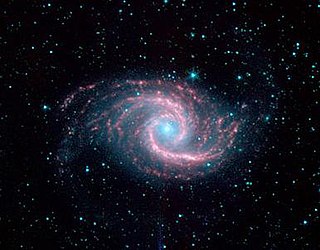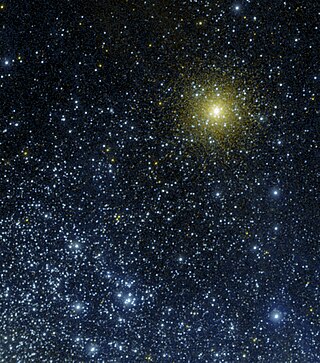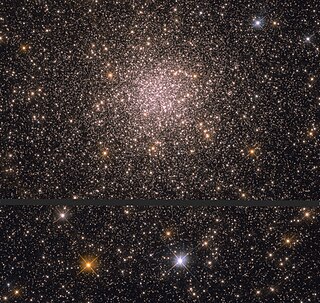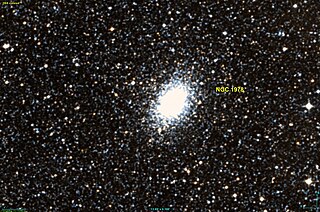
Dorado is a constellation in the Southern Sky. It was named in the late 16th century and is now one of the 88 modern constellations. Its name refers to the mahi-mahi, which is known as dorado ("golden") in Spanish, although it has also been depicted as a swordfish. Dorado contains most of the Large Magellanic Cloud, the remainder being in the constellation Mensa. The South Ecliptic pole also lies within this constellation.

NGC 1872 is an open cluster within the Large Magellanic Cloud in the constellation Dorado. It was discovered by James Dunlop in 1826.

NGC 1850 is a double cluster and a super star cluster in the Dorado constellation, located in the northwest part of the bar of the Large Magellanic Cloud, at a distance of 168 kly (51.5 kpc) from the Sun. It was discovered by Scottish astronomer James Dunlop in 1826.

NGC 1533 is a barred lenticular galaxy with faint spiral structure in the constellation Dorado. The seventh-brightest member of the Dorado Group and 1° off the group's center, it is surrounded by a vast arc or ring of H I which is connected to IC 2038 and IC 2039. The ring orbits around 32 kpc from the center. As is typical of lenticular galaxies, star formation is weak in NGC 1533. Using both the surface brightness fluctuation (SBF) and globular cluster luminosity function (GCLF) methods, its distance was estimated in 2007 to be 19.4 ± 1.1 Mpc and 18.6 ± 2.0 Mpc respectively. Averaging these together gives a distance of around 19 million parsecs or 62 million light-years from earth. In 1970, a supernova was detected in NGC 1533.

The Dorado Group is a loose concentration of galaxies containing both spirals and ellipticals. It is generally considered a 'galaxy group' but may approach the size of a 'galaxy cluster'. It lies primarily in the southern constellation Dorado and is one of the richest galaxy groups of the Southern Hemisphere. Gérard de Vaucouleurs was the first to identify it in 1975 as a large complex nebulae II in the Dorado region, designating it as G16.

NGC 1553 is a prototypical lenticular galaxy in the constellation Dorado. It is the second brightest member of the Dorado Group of galaxies. British astronomer John Herschel discovered NGC 1553 on December 5, 1834 using an 18.7 inch reflector.

NGC 362 is a globular cluster located in the constellation Tucana in the Southern Hemisphere, slightly north of the Small Magellanic Cloud, to which it is completely unrelated. It was discovered on August 1, 1826 by James Dunlop. It is visible to the naked eye in dark skies, and is an impressive sight in a telescope, although it is somewhat overshadowed by its larger and brighter neighbour 47 Tucanae.

NGC 1806 is a globular cluster located within the Large Magellanic Cloud within the constellation of Dorado, an area of the sky best seen from the Earth's southern hemisphere. It was discovered in 1836 by the British astronomer John Herschel. At an aperture of 50 arcseconds, its apparent V-band magnitude is 11.00, but at this wavelength, it has 0.05 magnitudes of interstellar extinction.

NGC 1856 is a young, massive star cluster similar to a "blue globular cluster" in the Magellanic Clouds in the constellation Dorado. Its age is estimated to be 80 million years. The object was discovered in 1826 by James Dunlop with a 9-inch reflecting telescope.

NGC 1868 is a globular cluster in the Large Magellanic Cloud in the constellation Dorado. It was discovered by John Herschel in 1834. The cluster is fairly metal-poor and as a result appears relatively blue. It maintains an abundant population of mature giant branch stars which have been used to fit its age to roughly 700 million years old. The cluster is located in a relatively sparse region of the Large Magellanic Cloud which has allowed it to be studied relatively free of crowding from background stars.

NGC 1783 is a globular cluster within the Dorado constellation and part of the Large Magellanic Cloud, a satellite dwarf galaxy of the Milky Way. At an aperture of 50 arcseconds, its apparent V-band magnitude is 10.39, making it one of the brightest globular clusters in the LMC as viewed from Earth. It was discovered in 1835 by John Herschel. The compiler of the New General Catalogue, John Louis Emil Dreyer, described this cluster as "considerably bright, large, round, very gradually pretty much brighter middle, mottled but not resolved."

NGC 6316 is a globular cluster located in the constellation Ophiuchus. Its Shapley-Sawyer Concentration Class is III, meaning that it has a "strong inner core of stars" and was discovered by the German-born British astronomer William Herschel on 24 May 1784. It is at a distance of about 37,000 light years away from the Earth. NGC 6316 has a metallicity of -0.45; this means that its ratio of hydrogen/helium to other elements is only 35% that of the Sun, but still enough to be considered a "metal-rich" globular cluster.

NGC 1854 is a young globular cluster in the northern part of the central bar structure of the Large Magellanic Cloud in the Dorado constellation. At 200x magnification the cluster appears very bright, large and round, with dozens of very faint stars visible. NGC 1858, a nebula/star cluster object, lies to the south-east.

NGC 1755 is an open star cluster in the Large Magellanic Cloud in the Dorado constellation. It is about 120 light years across and due to its size could be a globular cluster. It has a diameter of 2.6′ and an apparent magnitude of 9.9. It was discovered by James Dunlop in 1826.

NGC 1978 is an elliptical shaped globular cluster or open cluster in the constellation Dorado. It is located within the Large Magellanic Cloud. It was discovered by James Dunlop on November 6, 1826. At an aperture of 50 arcseconds, its apparent V-band magnitude is 10.20, but at this wavelength, it has 0.16 magnitudes of interstellar extinction. It appears 3.9 arcminutes wide. NGC 1978 has a radial velocity of 293.1 ± 0.9 km/s.

NGC 2108 is a globular cluster located in the constellation of Dorado. NGC 2108 was discovered in 1835 by John Herschel.

NGC 1898 is a globular cluster in the constellation of Dorado at an approximate distance of 170,000 light-years. NGC 1898 is located in the Large Magellanic Cloud, a satellite galaxy of the Milky Way, and was for some time believed to be discovered by John Herschel in 1834; however recent research shows it was first observed by James Dunlop in 1826.

NGC 1866 is a globular cluster in the Large Magellanic Cloud, located in the constellation of Dorado. NGC 1866 was discovered August 3, 1826 by James Dunlop.

NGC 1549 is an elliptical galaxy located in the constellation Dorado. It is located at a distance of about 50 million light years from Earth, which, given its apparent dimensions, means that NGC 1549 is about 75,000 light years across. NGC 1549 was discovered by John Herschel on 6 December 1835 and may have been observed by James Dunlop in 1826. It is a member of the Dorado Group.

NGC 2210 is a globular cluster located in the Large Magellanic Cloud, in the constellation Dorado. It is situated south of the celestial equator and, as such, it is more easily visible from the southern hemisphere. It was first discovered by astronomer John Herschel on January 31st, 1835. In 2017, Rachel Wagner-Kaiser and a group of researchers from the University of Florida discovered that NGC 2210, as well as five other globular clusters located in the Large Magellanic Cloud were of roughly the same age as some star clusters found in the Milky Way, and that NGC 2210 is roughly 11.6 billion years old. It was first imaged by the Hubble Space Telescope in 2023.




















